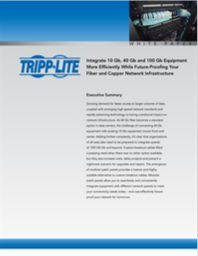Integrate 10 Gb, 40 Gb and 100 Gb Equipment More Efficiently While Future-Proofing Your Fiber and Copper Network Infrastructure
Growing demand for faster access to larger volumes of data, coupled with emerging high-speed network standards and rapidly advancing technology, is having a profound impact on network infrastructure. As 40 Gb fiber becomes a standard option in data centers, the challenge of connecting 40 Gb equipment with existing 10 Gb equipment moves front and center.
Custom breakout cables filled a pressing need when there was no other option available, but they also increase costs, delay projects and present a nightmare scenario for upgrades and repairs. The emergence of modular patch panels provides a mature and highly scalable alternative to custom breakout cables.
Download this whitepaper to learn more.
Read More
By submitting this form you agree to Tripp Lite contacting you with marketing-related emails or by telephone. You may unsubscribe at any time. Tripp Lite web sites and communications are subject to their Privacy Notice.
By requesting this resource you agree to our terms of use. All data is protected by our Privacy Notice. If you have any further questions please email dataprotection@techpublishhub.com
Related Categories: Components, Connectors, cooling, Industrial, Power, Switches


More resources from Tripp Lite

Common Power Problems & Power Protection Solutions
The importance of clean, reliable and continuous power is paramount for the technology we depend on in our everyday lives.
This white paper d...

Wall-Mount Rack Solutions for PCI Compliance
Credit, debit and ATM card fraud costs consumers, merchants and financial institutions billions in losses every year. The payment card industry has...

Tough Decision: On-Line or Line-Interactive UPS? How to Choose the Right Protection for Your Network
In today's data-driven, technology-dependent world, no organization – large or small – can afford the financial cost, customer frustration and ...
